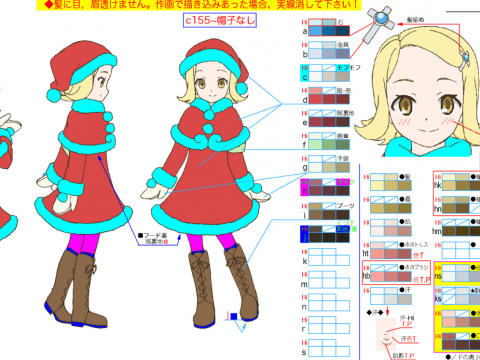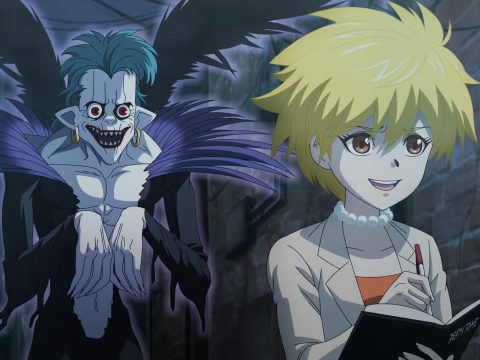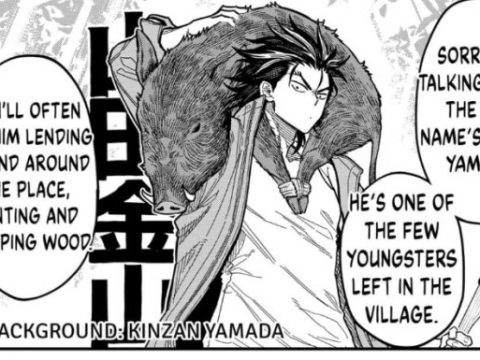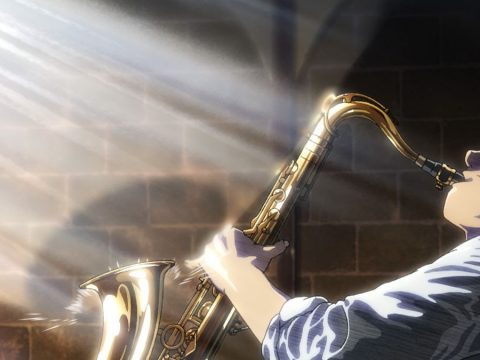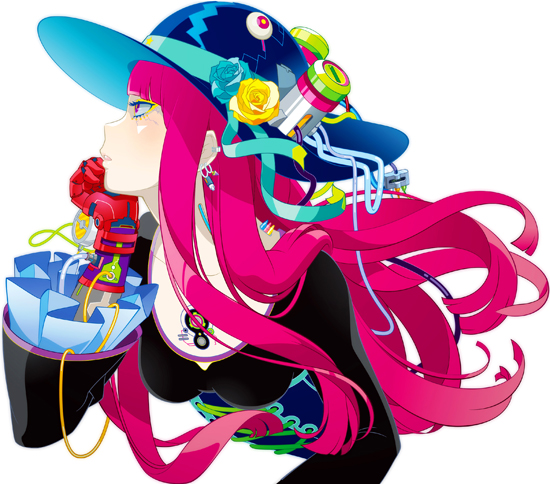
Is Hypersonic Music Club the comic-drawing debut of fashion/music/pop illustrator Hiroyuki Takahashi? Is Hypersonic Music Club the manga-writing debut of pop culture critic and Otaku USA Editor-in-Chief Patrick Macias (Tokyoscope: The Japanese Film Companion, Japanese Schoolgirl Inferno, Cruising the Anime City: An Otaku Guide to Neo Tokyo)? It’s both, of course (unless you count Macias’ other illustrated web-story, Paranoia Girls with Uchiyama Yunico, as a manga) but only Macias and Takahashi know just what else is going on in those fevered minds and unseen pages. Like a vector-graphics fusion of Jamie Hewlett and Shintaro Kago, Takahashi’s rainbow-colored, explosive art illustrates Macias’ science fiction story of monsters, cyborgs and seething technology. Running now on crunchyroll.com as the first of Crunchyroll’s “Manga Originals,” Hypersonic Music Club is like no other manga or comic you’ve read…and it’s definitely nothing like K-On!.
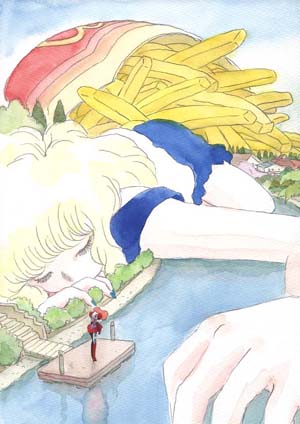
Paranoia Girls
Otaku USA: You’re known as a pop culture critic and writer, someone who writes about media, rather than making it. Have you always been interested in creating your own works?
Macias: I’ve always had fragments and notes for creative things I wanted to do going as far back as I can remember. If you look back at my blog over the last 10 years, there’s a bunch of crazy stream of consciousness posts (mostly written while losing my mind in Tokyo) where concepts like the Mystery Frequency and the Overtones, which are featured in Hypersonic, began to form.
Meanwhile, around 2012, there seemed to be this new wave of Japanese artists who were starting to pop up on the landscape. They were more like illustrators than anime and manga people, but they were deeply informed by otaku culture, and had a wide range of areas they could cross over into like, music and fashion. Developments like like pixiv and Vocaloid were important too in the way that they created a space for user-generated content in Japan, and talent could emerge outside of the usual channels of distribution like big publishers and TV companies. A lot of talented people suddenly started to throw down some really great work at the indie level.
I became a big fan of emerging artists like Hiroyuki Takahashi and Uchiyama Yunico (who I’m collaborating with on my other webcomic Paranoia Girls which I launched last summer) and since they’ve weren’t hidden behind walls of editors or uptight corporate ownership, it was really easy to reach out to them and meet up with in person and just see what was possible.
With Uchiyama, we bonded instantly over a love of cult movies and UK rock music, so that seemed like a good fit for Paranoia Girls.
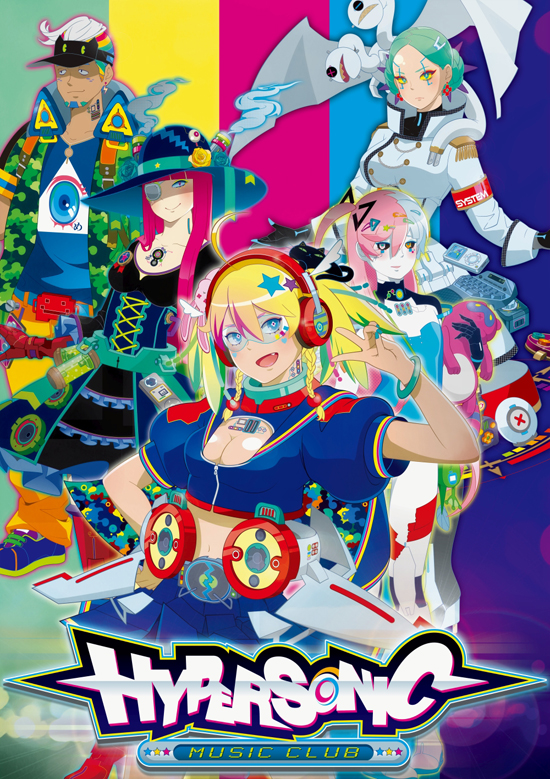
In Takahashi’s case, I really wanted him to create an original work—I thought his style of art would be a good fit in whatever form—for Crunchyroll, and the company was in a place where it could offer the resources to make that happen. I basically asked him, “would you like to collaborate on something, or would you prefer to do something solo?” He said he would prefer to work together, so I spent the next couple of months trying to figure out what kind of story and characters might work well with his art. Naturally some of my older blog-style ideas leaked into it, but the main inspiration for Hypersonic is foremost Takahashi’s incredible art. Clearly, if you just leave me alone with a laptop for a while, I will start to generate weird text on my own. But this whole project is really about trying to introduce his art and style to people who might not encounter it otherwise.
Otaku USA: Tell me more about Paranoia Girls. It reminds me of Post Secret, or A Softer World, that feeling like you’re reading someone’s diary.
Macias: Paranoia Girls is my look back my own psychedelic schooldays in suburbia. Also, it’s about trying out a softer, gentler almost storybook approach to all the mind control / conspiracy crazy stuff out there in the world that I love. The main inspiration came a while back, my friend Laura gave me a bunch of her old notes, letters, and diaries and said I was free to do whatever I wanted with it, so Paranoia Girls is about making a mythology out of that material as well. If you haven’t done it lately, it’s a very weird experience to dig around in a lot of old analog stuff, like the notes people used to pass to each other in class and stuff like that. Everyone just texts now; there’s no physical record of time passing anymore. So the stuff of everyday life from even just a few decades ago now seems like it’s from…another millennia!
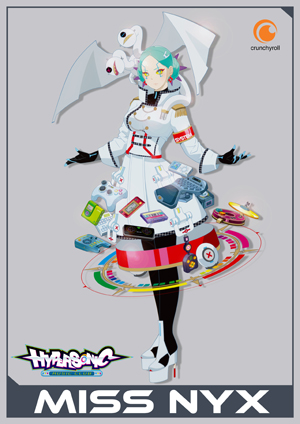
Otaku USA: Yes, we’re about the same age…it’s been interesting seeing how the ‘80s that we grew up in has started to appear in media as a different time and place with its own mood and rules, like in Higurashi When They Cry to use a Japanese example…
Macias: Like I said, with Paranoia Girls, the idea had been with me for a long time, but I didn’t know where to go with it. I could have just written a novel about it that two people, if that would read, but I sort of knew when I saw Yunico Uchiyama’s art that he was the guy who could really take it to the next level. I looked at as much of his art as I could, it triggered new
associations, so it developed into a real collaboration from here.
Otaku USA: You’ve developed two stories around artists with very distinct styles…
Macias: Paranoia Girls and Hypersonic are sort of related. The Mystery Frequency and the Overtones are in both. These are science fiction fantasy stories are that use things like electromagnetics and sound waves as jumping off points. In this current tech boom, I feel like people have sort of forgotten that physical reality is made up of things like radio waves and vibrating particles. Too busy texting, I guess.
Otaku USA: So what is the Mystery Frequency? Is it the Anti-Life Equation? Is it the singularity?
Macias: It’s a secret. But I can tell you this much: Paranoia Girls is about how the Mystery Frequency was discovered and how that lead to new kinds of technology, and how weird disembodied spirits got in the radio spectrum.
Otaku USA: You say the world of Hypersonic is “beyond advanced technology”…is it ‘goofy’ sci-fi or ‘serious’ sci-fi or a world so beyond ours it’s beyond goofy & serious?
Macias: Hypersonic is set in a futuristic world where maintenance is the single biggest problem: more tech meant more things to take care of and a lot of stuff fell through the cracks and no one has the time or resources to care much. Technology got to the cyborg/AI level, but then the inability to maintain everything was sort of the flashpoint apocalypse. I don’t know how goofy that idea is, but we’re definitely going to have fun with it. There will be some big dramatic notes for the characters, starting with the fact that they don’t always get along with each other, but it’s a really a story that is going to reflect the colorful cyber vibe in Takahashi’s art.
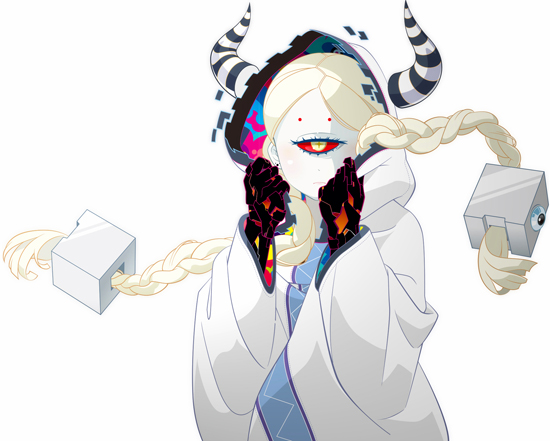
Otaku USA: So this is a full-on story manga, not a “just hangin’ out with the music club” manga?
Macias: For me, the genre is SF/action. There’s going to be knockdown, drag out fights with crazy weapons and I can’t wait to see how Takahashi will draw all that once we set everything up for a few pages.
Otaku USA: How significant is the music theme? Was this something that suggested itself because of Takahashi’s background? Are there particular songs or artists you feel capture the mood of the series? Where did you find the group whose music is on the tumblr, xbtcd13?
Macias: The music angle is very, very significant. When I first talked with Takahashi about what kind of story we were going to do, we both agreed that music was the sort of the way in. Takahashi designs a lot of club event fliers and CD jackets for remix compilations, so stuff like headphones and AV cables very much part of his visual vocabulary. He’s always referring to the rhythm of his compositions, and I have to admit, I start hearing crazy techno music in my head whenever I’m working on this project with him. I’m normally not a dance music expert, but I have to say, there’s a renaissance going on right now, and I’ve started listening to a lot of new techno from Japan, usually in the form of remixes, on Soundcloud. There’s so much stuff out there, and too many DJs to mention
but xbtcd13 is a good place to start. I don’t know much about who is making those mixes, but Takahashi designs the artwork for the xbtcd13 compilation CDs.
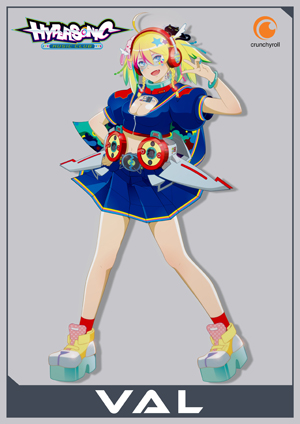
In addition, Takahashi started inviting me to club events whenever we were both in Tokyo, so I wound up getting an inside view at how those events were arranged and what the energy at them was like. I was really struck by the “anison” (anime song) events where DJs—usually in cosplay—would play the opening and ending themes of the latest shows while the audience lost their minds. It’s a very much a new style of otaku culture that encourages participation from everyone (male, female, hot, not) and breaks a lot of the anime fan stereotypes that have built up over the years. I’m already seeing signs of it taking off overseas, and I’d be very happy if anison events became more common around the world, just because they’re so much fun, and it’s a way to enjoy the culture that doesn’t involve just hiding in a room, tapping away on a computer.
Another thing that impressed me were the DJs themselves. In clubs outside of Japan, you’re very likely to just see a boring guy in a hoodie playing records for a bunch of people. But across the board in Japan, people approach the job like Pro Wrestlers: coming up with these oversized personalities, wild costumes, and special moves in the form of set lists. So that kind of vibe really fed into the creation of the characters of Hypersonic. They may seem over the top the first time you see them, but—minus a few cyborg modifications—they would not be all that out of place at an anison or “Heavy Pop” style event in Japan.
Otaku USA: Do you find your knowledge of otakudom to be helpful in constructing a story, or does it get in the way in a sense, since you’ve seen and analyzed so much stuff?
Macias: In terms of coming up with the story and characters, I never really hit a wall with it. Again, my main inspiration for Hypersonic is Takahashi’s art and the Tokyo club scene, not pre-existing work from other people, so I really held onto those things. I think just taking his art and plugging a bunch of anime clichés into it would be a disservice. So I guess I tried to avoid things like homages and references, but not in a conscious way, if that makes any sense.
Otaku USA: How did you select Takahashi? How did you discover his work?
Macias: I just thought was a perfect storm of sorts. It hits all these buttons in the otaku, music, and fashion in a way that feels authentically lived in, not coming from the outside. In addition to his amazing sense of color, his art is just so precise. He was trained in industrial design, so that gives him an amazing command of line. And my god, the detail… The fact that he does most of his art this just using the path function in Adobe Illustrator is just the cherry on top. He’s the best.
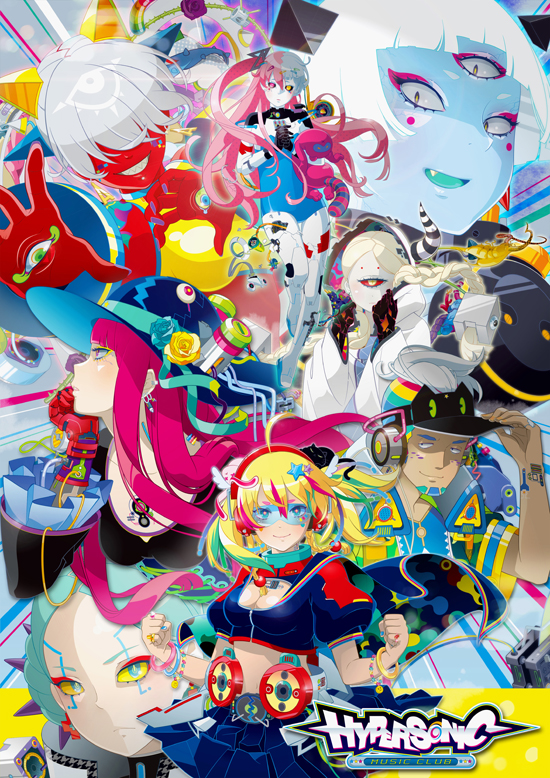
Otaku USA: How involved are you in coming up with the artwork and page layouts?
Macias: For pages of Hypersonic, I send Takahashi 1-2 pages of notes that explain how I see the image in my mind: what items are in it, what the mood is like, what the main action is, and whatever information that seems important or might be helpful. I also send a rough page layout that shows my ideas for composition, but he’s free to disregard it or tweak it anyway he wants. When he sends me his rough page layout, he’s definitely put his own spin on it, and his ideas improve on mine beyond my expectations. Then, I have to think about what the dialogue and captions will be, so I start to work on that before moving it onto the letterer. I’m not sure if this is Marvel style, or DC style, or how it stacks up to how manga is scripted and made in Japan, but it seems to be working for us!
Otaku USA: And meanwhile, the story of Paranoia Girls is continuing too?
Macias: Yes, Paranoia Girls is continuing as normal (as normal as Paranoia Girls can be…). We sort of just finished our first story arc, and we have all the main characters on the chess board, so now is probably a good time to check it out and lose your mind.
LINKS:


